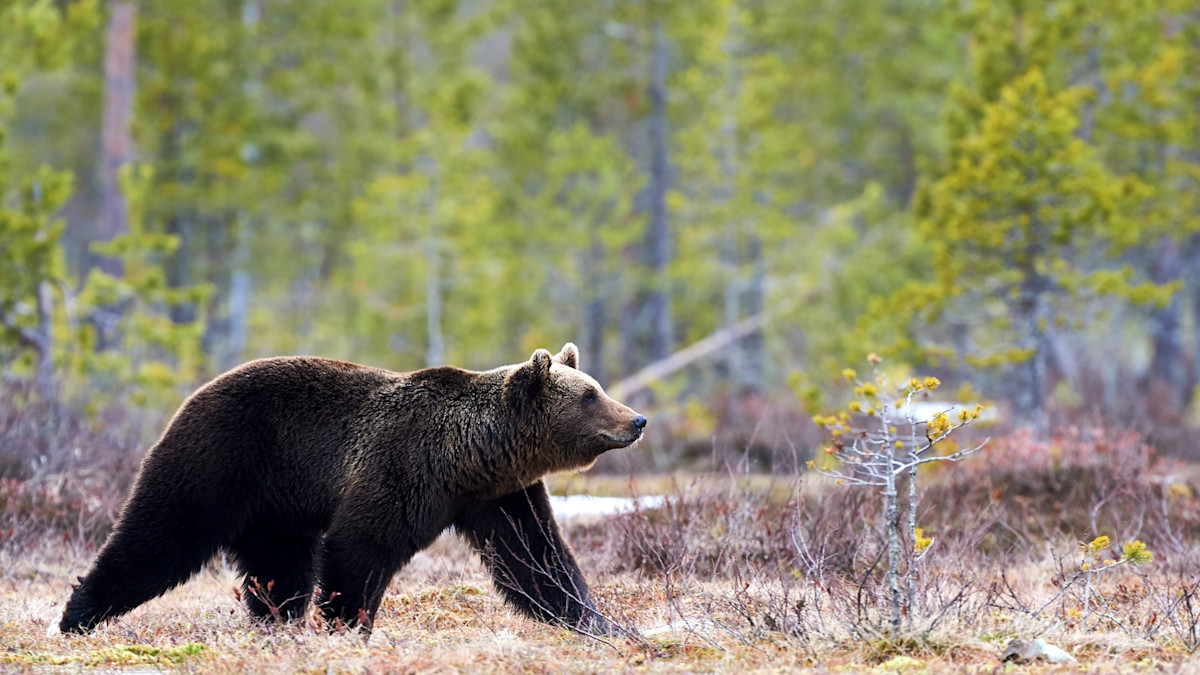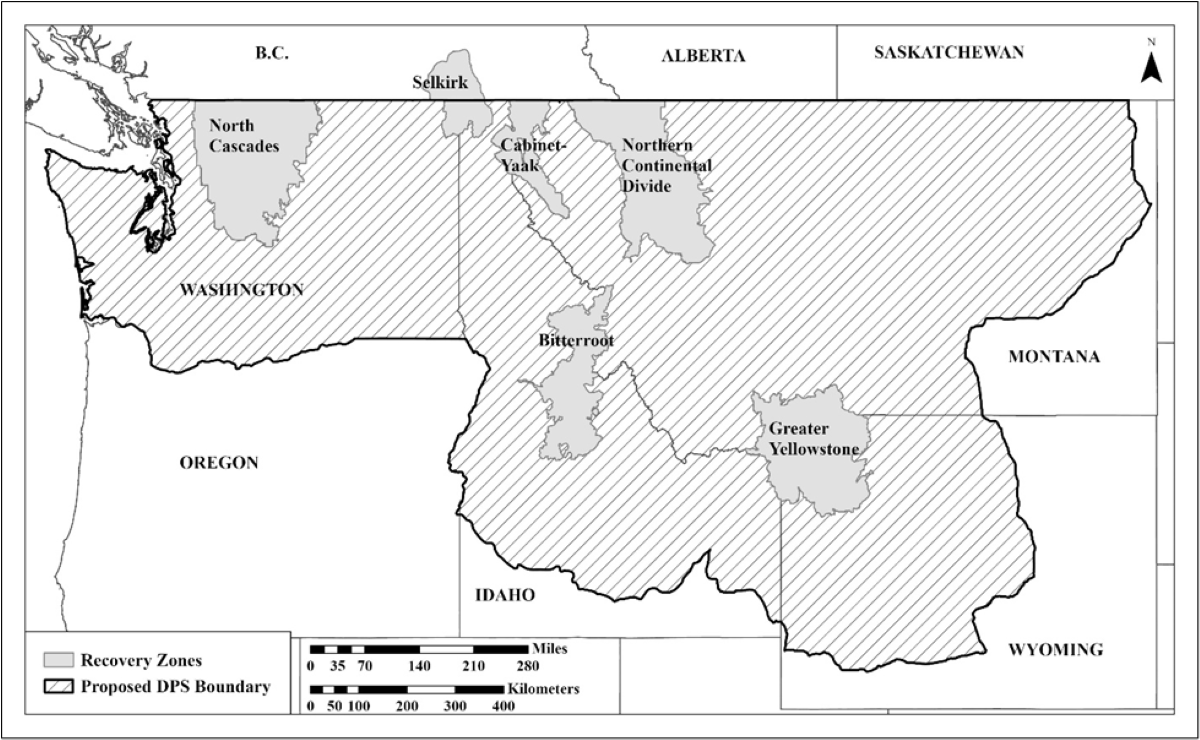Grizzly Bears Will Remain Protected by the Endangered Species Act, For Now

On Wednesday, the U.S. Fish and Wildlife Service (FWS) announced that grizzly bears will remain protected as a “threatened” species by the Endangered Species Act throughout their range in the Lower 48.
This decision comes in response to a series of petitions from Montana, Wyoming, and Idaho arguing that distinct population segments in the Greater Yellowstone (GYE) and Northern Continental Divide (NCDE) ecosystems have achieved recovery goals and, thus, warranted delisting. The NCDE and the GYE are two of six grizzly bear recovery zones across the West.
In addition to the decision to keep grizzly bear management in the Lower 48 in the hands of the federal government, FWS also issued a proposal to fundamentally change how grizzly bear population segments are mapped and managed. Rather than continuing to direct grizzly bear recovery efforts in the six distinct zones—the Bitterroot Ecosystem, the North Cascades Ecosystem, the Selkirk Ecosystem, and the Cabinet-Yaak ecosystem, in addition to the GYE and NCDE—grizzly recovery would occur over one large swath encompassing the entirety of Washington State, most of Idaho, almost half of Wyoming, and all but the easternmost part of Montana, if passed.
The purpose of this change is to address how migration, augmentation, and growing grizzly populations all complicate delisting individual recovery zones, according to FWS.
“As bears continue to expand, populations are becoming less separate and distinct,” FWS said. “This increased movement between recovery areas and into connectivity areas demonstrates the remarkable success of conservation and management efforts…However, these developments also emphasize the need to implement and maintain conservation measures to encourage continued grizzly bear movement across these regions.
“The recovery of smaller populations, such as those in the CYE and SE, and extirpated populations, like the BE, depends on the contributions of larger, more resilient populations, such as those in the NCDE and GYE,” FWS continues. “Maintaining all recovery zones within a single distinct population segment will accelerate recovery in remaining ecosystems and enhance the overall viability of grizzly bears.”

The proposal mirrors some suggestions outlined in a petition filed on December 11 by 15 animal welfare and environmental activist groups, including Earthjustice, the Center for Biological Diversity, Wild Earth Guardians, the Humane Society of the United States, and others, backed by former FWS grizzly bear recovery coordinator Dr. Chris Servheen. By calling for amendments to the 1993 Grizzly Bear Recovery Plan, which Servheen prepared, the petition proposes a similar overhaul of the recovery zones aimed at recovering a “metapopulation” of grizzly bears across the northern U.S. Rocky Mountains. (The most recent FWS decision and proposal is not in direct response to this petition. It only addresses earlier petitions from officials in Montana, Wyoming, and Idaho.)
“The 1993 Grizzly Bear Recovery Plan neither envisioned nor addressed the modern-day threats facing grizzly bears in the Northern U.S. Rockies today,” Servheen said in a report attached to the December 11 petition. “Dramatic increases in human population within grizzly bear habitat and regressive anti-carnivore policies recently enacted by the states have caused rising and unprecedented mortality risks to grizzly bears. At heart, this proposal seeks to address these previously unrecognized threats while also offering a plan to achieve lasting recovery for grizzly bears in the Northern U.S. Rockies.”
Servheen goes on to propose that the amended 1993 plan “implement practices endorsed by the best available science” to manage grizzlies as a “single, unified metapopulation,” and for state and federal wildlife management agencies to strengthen regulations protecting grizzlies from human-caused mortality and further habitat loss.
A total of 1,691 grizzly mortalities occurred in the GYE, NCDE, Cabinet-Yaak, and U.S. portion of the Selkirk ecosystems between 2002 and 2023, a table in the FWS proposal details. Of those mortalities, 586 were in management scenarios due to site conflicts, human safety risk, injured or diseased bears, and livestock depredations. Another 301 were defense-of-life scenarios. Together, these instances resulted in over half of all grizzly mortality in that timeframe.
Another 257 mortalities were accidental, due to vehicle collisions, captures, drownings, poisonings, or train collisions. Illegal kills numbered 146, although that figure combines poachings and malicious kills with defense-of-property kills. Cases of mistaken identity accounted for another 61 mortalities. The remainder of the mortalities were due to natural, undetermined, and unknown causes.
In an ecological context, a “metapopulation” is “any assemblage of discrete local populations with migration among them,” according to the definition Servheen cites. The phrase “metapopulation” does not surface anywhere in the FWS proposal materials, but it seems to be at the core of the new DPS map. Servheen is acknowledged, seemingly as a reviewer, in the updated species assessment attached to the proposal.
With the upcoming administration change, there is no guarantee that the proposal lasts much past January 20. If it were to be accepted, this would not mean grizzlies would suddenly show up in downtown Boise or on the shores of Puget Sound. But it does mean that, if grizzly bear delisting ever happens, it would happen everywhere all at once rather than on a zone-by-zone basis.
One of the current criteria for grizzly bear recovery and delisting in the NCDE and GYE is genetic diversity and interbreeding between the two population segments. To expedite that process, Montana Fish, Wildlife, & Parks coordinated the relocation of two grizzly bears from the NCDE to the GYE in August 2024, partially as an attempt to show their readiness to assume management of the species should a delisting occur.
Now, Governor Greg Gianforte rips the decision to shreds in a highly politicized press release that took aim at seemingly every element of the Biden Administration, including the grizzly decision.
“The full recovery of the grizzly bear across the Rocky Mountain region should be acknowledged and celebrated – period,” Gianforte said. “It’s time for [the] U.S. Fish and Wildlife Service to catch up with the science, follow the law, and return management of grizzlies to the states, where it belongs. We look forward to working with the incoming Trump administration to explore a new path forward.”
The notice of the FWS proposal was published in the Federal Register on Thursday. MeatEater contacted multiple wildlife conservation organizations, but they declined to comment on the proposal at this time, citing a need to read it in its entirety before forming statements.
The public now has 60 days to comment on the proposal, and instructions on how to do so are in the notice. Public meetings on the proposal are as follows:
- January 28, Missoula, Montana
- January 29, Coeur d’Alene, Idaho
- January 30, Virtual
- February 10, Cody, Wyoming
All in-person events will feature a public informational meeting from 3 p.m. to 5 p.m. and a public hearing from 6 p.m. to 8 p.m. The virtual event will only feature an informational meeting from 6 p.m. to 8 p.m.
FWS will come to a final decision on the proposal by January 2026.





